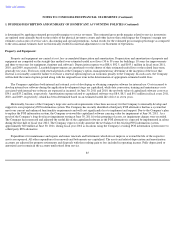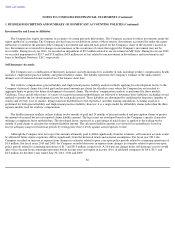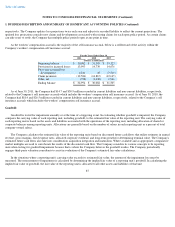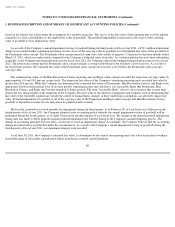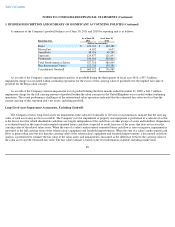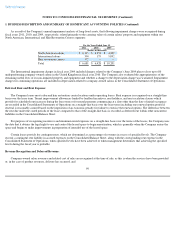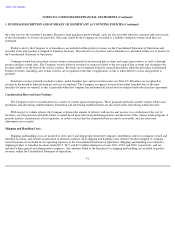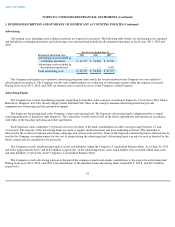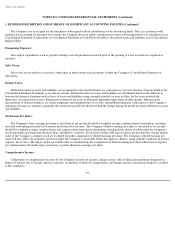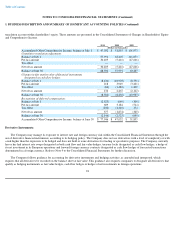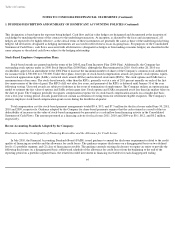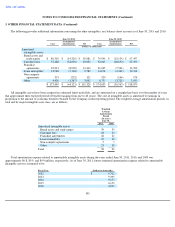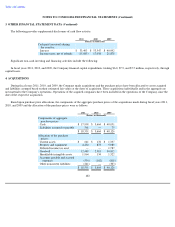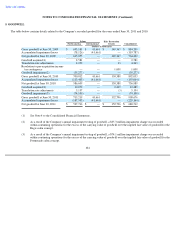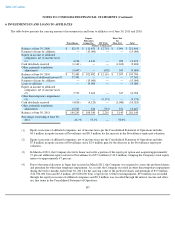Supercuts 2011 Annual Report Download - page 99
Download and view the complete annual report
Please find page 99 of the 2011 Supercuts annual report below. You can navigate through the pages in the report by either clicking on the pages listed below, or by using the keyword search tool below to find specific information within the annual report.
Table of Contents
NOTES TO CONSOLIDATED FINANCIAL STATEMENTS (Continued)
1. BUSINESS DESCRIPTION AND SUMMARY OF SIGNIFICANT ACCOUNTING POLICIES (Continued)
This designation is based upon the exposure being hedged. Cash flow and fair value hedges are designated and documented at the inception of
each hedge by matching the terms of the contract to the underlying transaction. At inception, as dictated by the facts and circumstances, all
hedges are expected to be highly effective, as the critical terms of these instruments are generally the same as those of the underlying risks being
hedged. All derivatives designated as hedging instruments are assessed for effectiveness on an on-going basis. For purposes of the Consolidated
Statement of Cash Flows, cash flows associated with all derivatives (designated as hedges or freestanding economic hedges) are classified in the
same category as the related cash flows subject to the hedging relationship.
Stock-Based Employee Compensation Plans:
Stock-based awards are granted under the terms of the 2004 Long Term Incentive Plan (2004 Plan). Additionally, the Company has
outstanding stock options under its 2000 Stock Option Plan (2000 Plan), although the Plan terminated in 2010. On October 28, 2010 our
stockholders approved an amendment to the 2004 Plan to increase the maximum number of shares of the Company's common stock authorized
for issuance from 2,500,000 to 6,750,000. Under these plans, four types of stock-based compensation awards are granted: stock options, equity-
based stock appreciation rights (SARs), restricted stock awards (RSAs) and restricted stock units (RSUs). The stock options and SARs have a
maximum term of ten years. The stock-based awards, other than the RSUs, generally vest at a rate of 20.0 percent annually on each of the first
five anniversaries of the date of grant. The RSUs cliff vest after five years, and payment of the RSUs is deferred until January 31 of the year
following vesting. Unvested awards are subject to forfeiture in the event of termination of employment. The Company utilizes an option-pricing
model to estimate the fair value of options and SARs at their grant date. Stock options and SARs are granted at not less than fair market value on
the date of grant. The Company generally recognizes compensation expense for its stock-based compensation awards on a straight-line basis
over a five-year vesting period. Awards granted do not contain acceleration of vesting terms for retirement eligible recipients. The Company's
primary employee stock-based compensation grant occurs during the fourth fiscal quarter.
Total compensation cost for stock-
based payment arrangements totaled $9.6, $9.3, and $7.5 million for the fiscal years ended June 30, 2011,
2010 and 2009, respectively. Guidance adopted by the Company for share-based payments requires that the cash retained as a result of the tax
deductibility of increases in the value of stock-based arrangements be presented as a cash inflow from financing activity in the Consolidated
Statement of Cash Flows. The amount presented as a financing activity for fiscal years 2011, 2010 and 2009 was $0.1, $0.2, and $0.2 million,
respectively.
Recent Accounting Standards Adopted by the Company:
Disclosure about the Credit Quality of Financing Receivables and the Allowance for Credit Losses
In July 2010, the Financial Accounting Standards Board (FASB) issued guidance to amend the disclosure requirements related to the credit
quality of financing receivables and the allowance for credit losses. The guidance requires disclosures on a disaggregated basis on two defined
levels: (1) portfolio segment; and (2) class of financing receivable. The guidance amends existing disclosures to require an entity to provide the
following disclosures on a disaggregated basis: rollforward schedule of the allowance for credit losses from the beginning to the end of the
reporting period on a portfolio segment basis, the related recorded investment in financing receivables for each disaggregated ending
95


